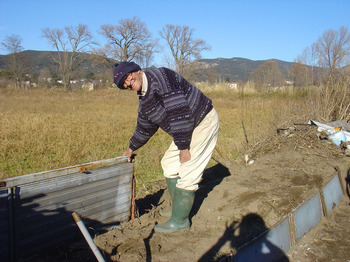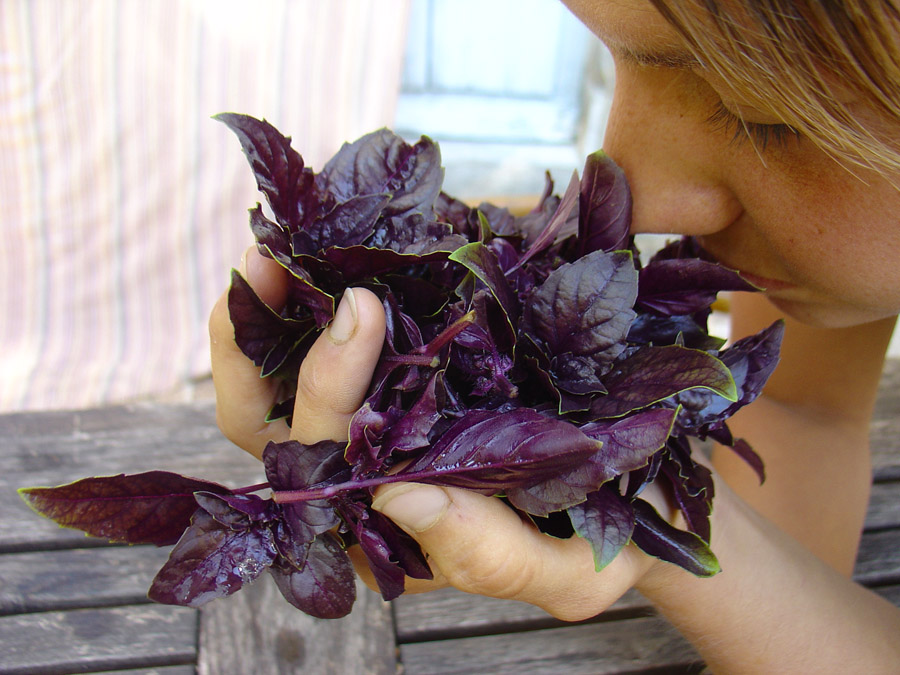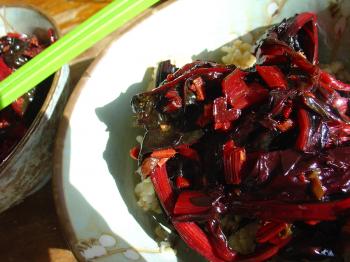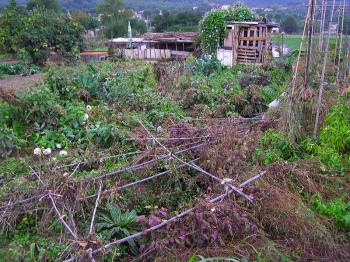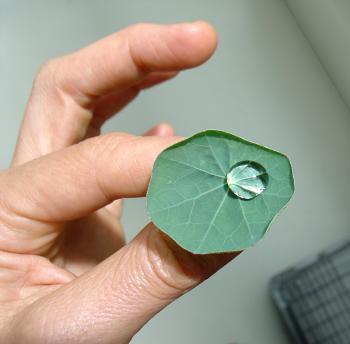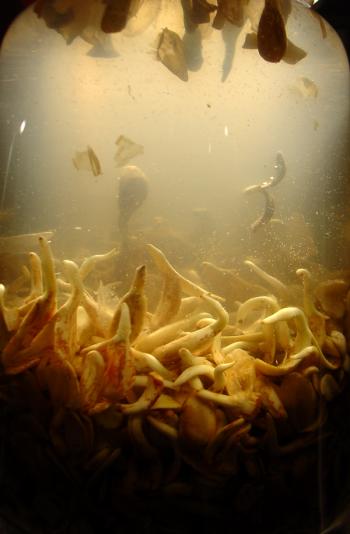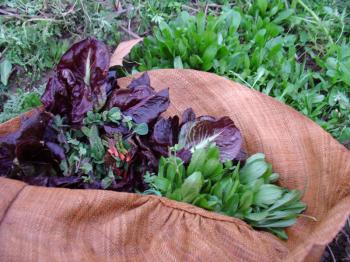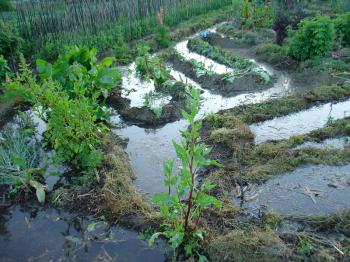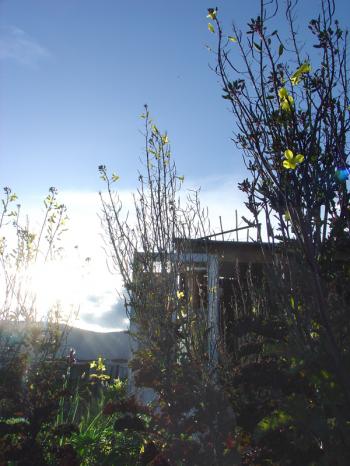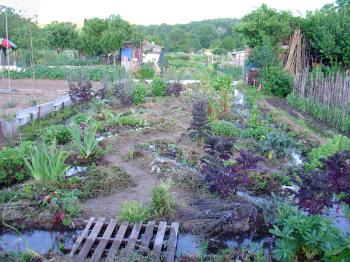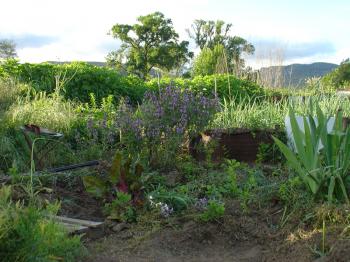Dike break at sunset
May 16, 2007
Each time I leave my Occitanian kitchen garden to go back to the Polar Circle, my neighbour Sidi ElGouche agrees to water for me a few times a week. Although he just has to divert the pipe between our allotments, let ‘er rip and redivert once my garden has had a good soaking, it’s a generous gesture and is both a testament to my absence and his presence down at the gardens. Right before I go I usually test the irrigation to see how my channels are holding up though testing without the time or intent to fix is stupid as you can readily see in the above photo. In the most optimistic sense this image reveals that I have come to embrace my life the Netherlands down to the very marrow of my bones. But on a more basic level, it reveals a break in the dike of my kitchen garden nearly 1200 kilometres away.
Granted, it’s uncommon to commute such great distances between kitchen and garden but the upside is a self-invented form of gardening which I call permaculture, after a fashion. In the spirit of ‘whatever works, works’ I still have two food and seed-producing plots that on some level and de temps en temps can be managed with minimal input on my part. I said on my part. The potager works in no small part due to the fact that I have a generous neighbour, a flowing river rushing with free water, and a well-intended irrigation system, leaky though it may be.
You can get a lot done in five days of gardening, but that doesn’t leave a lot of time for rumniating and fancy planning. I devoted an entire day to the borders of the upper garden in the hope of infusing them with shots of colour and activating the berm with self-seeding annuals and perrenials. But there was simply no time for coherent garden design. It still takes me ages to imagine how to plant the spikey and bushy foliages, how to group the edibles with the perrenials and mostly edible annuals, and to decide where the vertical gardening should happen. And I know what I don’t like more than I know what I do. For example, I know that I don’t like pink. Good planning aside, it’s not for nothing that Kristi and I coined the saying, Pink Happens. Depending what pops up this year, we’ll probably be extending that to include, White Happens and Pastels Happen.
On the brighter side of irrigation, I did manage to replace the white clover with bergamot and mint as a way of lining the watering channels. It’s going to be a perfumey summer in the waterways, picking strawberries and flowers, inadvertently stepping on the leaves and stems of the mint and bergamot, while my garden sips Earl Grey tea.
debra at 14:28 | Comments (0) | post to del.icio.us
Monument of Sugar
May 9, 2007
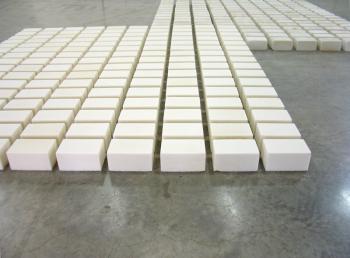
Secretly snapped photo of the installation Monument, now on exhibit at the Palais de Tokyo
Monument en Sucre is an installation by artists van Brummelen & de Haan documenting an artist attempt to avoid European sugar tariffs by re-importing European sugar dumped in Nigeria back into Europe as a work of art. The work is now on exhibit at the Palais de Tokyo in Paris. The accompanying booklet reports the artists’ mishap-filled adventures of searching for European sugar in the ports of Lagos and which reveals the artists’ engagment with the black-caped and mustache-twirling entity that is the international sugar (commodities) market.
The installation is beautiful in its starkness, a huge contrast to the more playful installation at the PdT by Michel Blaszy which, although also using the dynamic of ‘entropy’ involves lots of yogurt-washed walls, mildew, ramen and bird poo. The blocks forming van Brummelen and de Haan’s grid are truly sugar, I know because I was visiting Paris that week with my parents, and a sudden adult-behaviour-overload caused me to lash out at the artwork and lick it. Faithful culiblog readers can contextualise my reaction by remembering that there was a time in my family that sugar was referred to as ‘White Death’, ironic considering sugar’s connection with slavery, sugar could’ve better been referred to as ‘Black Death’, but that name was already taken.
But back to the work, Monument en Sucre is meaningful as an expression of an artist intervention with positively insane and protectionist trade policies. I don’t know if it was intentional, but I couldn’t help but think of the parallels between the commodiies and art markets.
Italicized text taken and then slightly altered from the Palais de Tokyo website.
Dutch artist duo Lonnie van Brummelen and Siebren de Haan use photography, writing, film and installations to explore political questions, ranging from the status of the artist to the economic consequences experienced by a country joining the European Union. The artists consistently raise political questions about the institutionalisation, particularly of art, thereby linking ethics and aesthetics.For their ambitious new project, shown here for the first time in France, the artists have travelled from Poland to Nigeria researching the cost of sugar in the world. Intrigued by the derisory price of European sugar outside Europe, they decided to reverse the flow of sugar by buying the European excess cheaply in Nigeria and shipping it back to Europe. The result of this expedition, Monument en sucre [Monument of Sugar], is shown at the Palais de Tokyo with a 16mm film, sculptures made of sugar and a publication that follow the whole process of making the works.
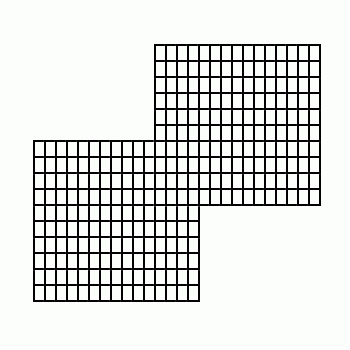
Author’s impression of artists’ diagram of Monument en Sucre by van Brummelen & de Haan 2007
- Palais de Tokyo website
- Sugar is of course connected to issue of Peak Oil
- Ethanol fuel in Brazil. In van Brummelen & de Haan’s work, Monument en Sucre, 2007, the artists ended up having to settle for using Brazilian sugar when they were unable to find European dumped sugar in Nigeria.
- There’s no Sugar Protocol, but there’s certainly a Cocoa Protocol
- Here’s the text of the Cocoa Protocol
- And here’s the critique of the Cocoa Protocol
debra at 13:24 | Comments (0) | post to del.icio.us

